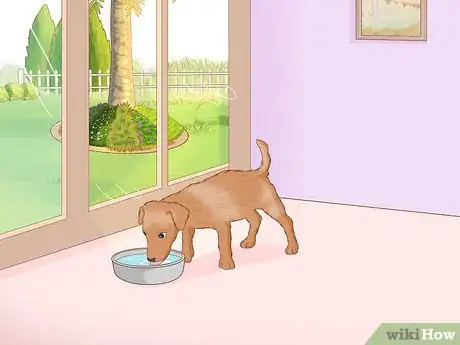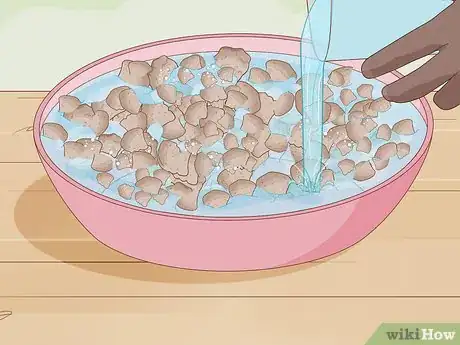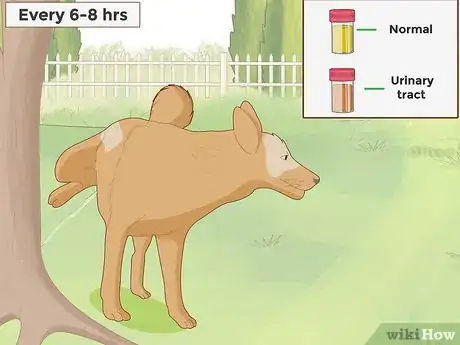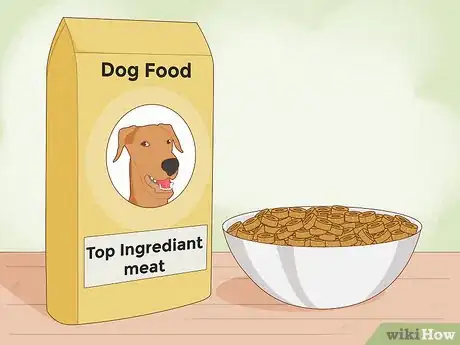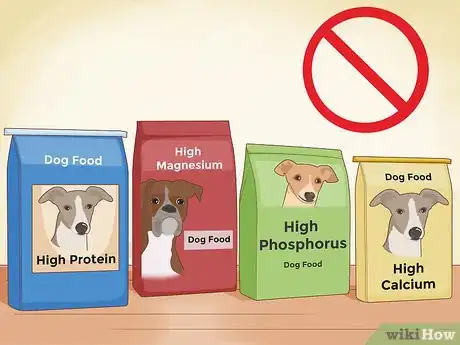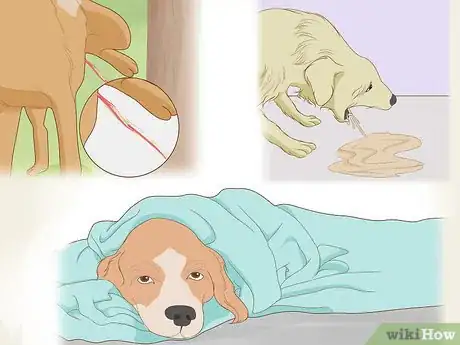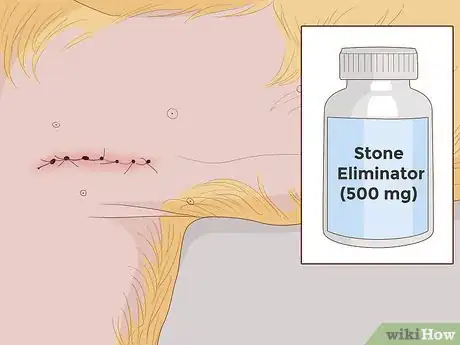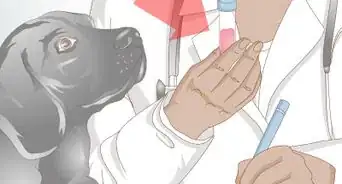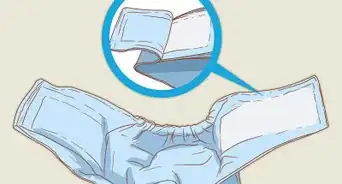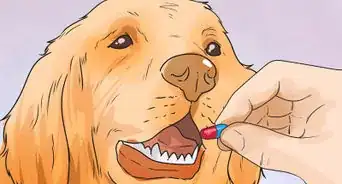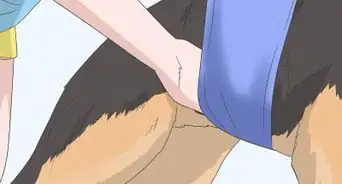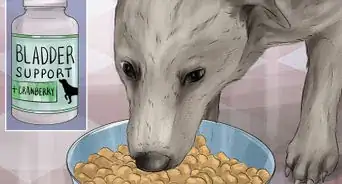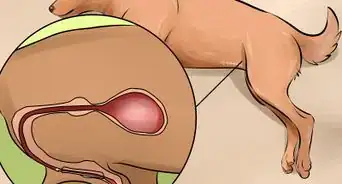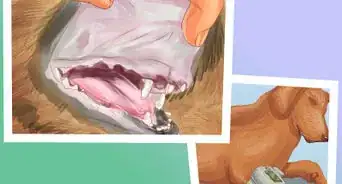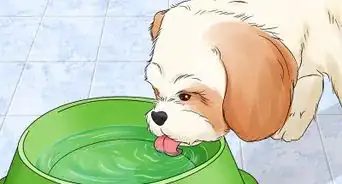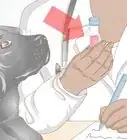This article was co-authored by Natalie Punt, DVM. Dr. Natalie Punt is a Veterinarian and the Founder and CEO of mPet- a smart phone app for pet owners to store, manage and transfer their pets medical records and health information. She specializes in small animal emergency and general medicine and veterinary practice economics. Dr. Punt holds a BS in Biochemistry and Molecular Biology from The University of California, Davis, an MS in Biochemistry from The University at Buffalo, and a DVM from Western University of Health Sciences.
There are 8 references cited in this article, which can be found at the bottom of the page.
wikiHow marks an article as reader-approved once it receives enough positive feedback. In this case, several readers have written to tell us that this article was helpful to them, earning it our reader-approved status.
This article has been viewed 122,620 times.
Dogs may get kidney stones when their urine has a high concentration of mineral salts, which come out of the urine. These mineral salts form a stone in the urinary tract or kidneys. Kidney stones may also be caused by urinary tract infections (UTIs), kidney infections, medications, age, diet or because of the breed of dog. They are also known as nephrolithiasis or uroliths which mean calculi or stones in the kidney or urinary tract respectively.[1] By learning more about what may increase your dog’s chances of developing kidney stones, you can take steps to help prevent them.
Steps
Keeping Your Dog Hydrated
-
1Make sure that your dog always has access to fresh, clean water. Water helps to dilute your dog’s urine, which keeps the minerals in the urine suspended in fluid. Drinking enough water also makes your dog urinate on a regular schedule, which helps to flush the minerals in the urine from your dog’s body.
- Change your dog’s water every day and clean his bowl a few times a week to minimize bacteria.
-
2Give your dog the right amount of water every day. The amount of water a dog needs every day is related to its body weight. A dog needs about an ounce of water per pound of body weight per day.[2] For example, an 8 pound dog will need a cup of water per day and an eighty pound dog will need 10 cups of water a day.
- Keep in mind that if your dog is physically active, pregnant, or nursing, then he will need more water.
- Provide extra water in hot weather. Provide your dog with a reliable source of clean, fresh water at all times, especially during hot weather.
- Provide unfrozen water in cold weather. Dogs cannot obtain the amount of water they need from eating snow or ice. In fact, eating snow and ice requires more body energy to melt the snow/ice which makes the dog’s body require even more water.
Advertisement -
3Add water to your dog's food if he is not drinking enough water. If your dog is a fussy drinker or you don’t think he is consuming enough water during the day, you can try adding warm water to your dog’s food until it reaches a stew-like consistency. You can also add wet canned foods to your dog to get more water in his system.
- Just make sure that you provide fresh, clean water for your dog, even if you are feeding your dog a wetter food.
-
4Allow your dog to go potty often. A healthy adult dog must have the opportunity to relieve itself of urine every 6 to 8 hours. Smaller dogs, puppies, or dogs with medical problems of the urinary tract will need to urinate more often, at least every 4 hours.
- If you are cannot take your dog out as often as he needs to be, you may want to consider installing a doggy door so that your dog can access an enclosed back yard, training your dog to use potty training pads in the house, or hiring a dog walker to walk your dog a few times a day.
- About once per week, observe your dog as it urinates. If the urine is a dilute yellow color, then his urine is normal. If your dog’s urine is brown or red and/or if your dog has trouble urinating, then you should contact your dog’s veterinarian right away.
Managing Your Dog’s Nutrition
-
1Choose a high-quality commercial dog food. Look for brands that list meat (not meat by-products) as the top ingredients on the labels or ask your veterinarian for advice. While it is not necessary to put your dog on a special diet to prevent kidney stones, you should still feed your dog a food that meets all of his nutritional needs. These needs will depend on your dog’s breed, age, and other factors.[3]
- Talk to your veterinarian if you are not sure how to choose a food for your dog.
-
2Follow your veterinarian’s recommendations for food. If your dog is prone to urinary tract infections or has been diagnosed with kidney stones in the past, then you will need to follow your veterinarian’s food recommendations for your dog. Your veterinarian will recommend a special diet (including special treats) to help prevent a reoccurrence of kidney stones.[4]
- Foods that are high in calcium, magnesium, phosphorus and protein can cause kidney stones due to high mineral and protein content in the urine. In dogs susceptible to kidney stone formation, foods that are lower in these nutrients (while still providing adequate amounts) can help to prevent the formation of kidney stones and may even help to dissolve very small stones.
- There are many types of kidney stones. The most common ones are struvites (made up of magnesium-ammonium-phosphorus); calcium oxalate (made up of calcium) and uric acid stones (the type Dalmatians are prone to get.) There can also be mixed types. By analyzing your dog’s urine, your veterinarian can determine which type of kidney stone your dog has and which food would be most appropriate for your dog to eat.
- A diet formulated to alleviate the formation of stones will usually have a different pH. It will be more acidic, with a lower concentration of certain types of minerals and proteins.
-
3Talk to a pet nutrition expert if you make your dog’s food from scratch. If you feed a home-made diet to your dog, speak with a pet nutrition expert to make sure the vitamin and mineral levels in the diet are balanced. A mineral imbalance (especially calcium and phosphorus) can cause kidney problems for your dog.[5]
- Your veterinarian may also be able to advise you on how to meet all of your dog’s nutritional needs with a home-made diet.
-
4Consider urinary tract health supplements. There are supplements that you can give your dog to help with urinary tract health. These include cranberry extracts, which are known to be beneficial for urinary tract health. Cranberries help prevent bacteria in the urine from latching onto the urinary tract lining.[6]
- These supplements are available in pill, capsule, or a chewable form to supplement your dog’s regular diet. If your dog has a medical condition, ask your veterinarian before giving any supplement to your dog.
Understanding Kidney Stones
-
1Recognize the signs and symptoms of kidney stones. In some cases, there are no obvious signs that a dog has a kidney stone. Kidney stones might be found during an x-ray or ultrasound for another condition in the affected dog. In other cases, there are certain clues or signs that might make a veterinarian suspicious that a dog has a kidney stone. These include:[7]
- Blood in the urine
- Frequent urination and increased drinking
- Recurring urinary tract infections
- Loss of appetite
- Vomiting
- Weight loss
- Difficulty urinating
- Lack of energy
- Painful belly
-
2Understand how kidney stones form. Kidney stones are the result of minerals found in the urine. The kidney is the urine formation organ in the body. In some cases, as the urine forms the minerals which should dissolve in the urine do not dissolve. Instead, they start forming into stones.
- These stones can be microscopic or large enough to fill cavities in the kidney. Regardless of size these are not normal and can potentially damage the kidneys.[8]
-
3Learn about the effects of kidney stones. Kidney stones can block your dog's urine flow and cause his kidneys to swell if the stone is too large. A blockage may result in serious illness and even death, so it is crucial to contact your veterinarian right away if you suspect that your dog has a kidney stone.[9]
- Kidney stones may also lodge in the bladder or start to form in the bladder itself. This process is more common and some dogs’ bladders may fill completely with stones. No matter where a stone forms, it will cause infection and on-going damage to the kidney or bladder.
-
4Keep in mind that some breeds are more likely to get kidney stones. Certain dog breeds are more susceptible to kidney stones than others. It is good to know if your dog is one of these breeds so that you can check for symptoms more often.[10]
- Lhasa Apsos, Yorkshire Terriers, and Miniature Poodles are more susceptible to kidney stones made of calcium and oxalic acid.
- Dalmatians, Yorkshire Terriers, and English Bulldogs. are more susceptible to kidney stones made of uric acid.
-
5Understand the common treatments for kidney stones. If you think that your dog has a kidney stone, you will need to take him to the veterinarian as soon as possible. Do not wait or the stones may become much worse. Treatments for kidney stones vary depending on the severity of the stones. Treatments may include medication, dietary changes, and even surgery.[11]
- Keep in mind that if your dog requires surgery, then he may need to be hospitalized until he recovers from the surgery.
- If your dog has stones and you don't want it to go through a surgery, there's a procedure called lithotripsy, in which the vet uses lasers to break down the stones.
Expert Q&A
-
QuestionHow can you tell if your dog has kidney stones?
 Pippa Elliott, MRCVSDr. Elliott, BVMS, MRCVS is a veterinarian with over 30 years of experience in veterinary surgery and companion animal practice. She graduated from the University of Glasgow in 1987 with a degree in veterinary medicine and surgery. She has worked at the same animal clinic in her hometown for over 20 years.
Pippa Elliott, MRCVSDr. Elliott, BVMS, MRCVS is a veterinarian with over 30 years of experience in veterinary surgery and companion animal practice. She graduated from the University of Glasgow in 1987 with a degree in veterinary medicine and surgery. She has worked at the same animal clinic in her hometown for over 20 years.
Veterinarian The signs of kidney stones include fever, abdominal pain, vomiting, and blood in the urine. However, these are general symptoms and don't in themselves diagnose kidney stones. To do this, the vet needs to radiograph or ultrasound the dog's kidneys in order to actually see the stone and make a definite diagnosis.
The signs of kidney stones include fever, abdominal pain, vomiting, and blood in the urine. However, these are general symptoms and don't in themselves diagnose kidney stones. To do this, the vet needs to radiograph or ultrasound the dog's kidneys in order to actually see the stone and make a definite diagnosis. -
QuestionHow much does it cost to have bladder stones removed from a dog?
 Pippa Elliott, MRCVSDr. Elliott, BVMS, MRCVS is a veterinarian with over 30 years of experience in veterinary surgery and companion animal practice. She graduated from the University of Glasgow in 1987 with a degree in veterinary medicine and surgery. She has worked at the same animal clinic in her hometown for over 20 years.
Pippa Elliott, MRCVSDr. Elliott, BVMS, MRCVS is a veterinarian with over 30 years of experience in veterinary surgery and companion animal practice. She graduated from the University of Glasgow in 1987 with a degree in veterinary medicine and surgery. She has worked at the same animal clinic in her hometown for over 20 years.
Veterinarian Cystotomy and stone removal is major abdominal surgery and this is reflected in the price. Expect to pay a significant amount of money. Prices vary between clinics and in different areas, so phone the vet and ask for an estimate. All vets should be willing to provide an estimate for a procedure on an animal under their care, so you can make an informed decision.
Cystotomy and stone removal is major abdominal surgery and this is reflected in the price. Expect to pay a significant amount of money. Prices vary between clinics and in different areas, so phone the vet and ask for an estimate. All vets should be willing to provide an estimate for a procedure on an animal under their care, so you can make an informed decision. -
QuestionWhat causes crystals in a dog's urine?
 Pippa Elliott, MRCVSDr. Elliott, BVMS, MRCVS is a veterinarian with over 30 years of experience in veterinary surgery and companion animal practice. She graduated from the University of Glasgow in 1987 with a degree in veterinary medicine and surgery. She has worked at the same animal clinic in her hometown for over 20 years.
Pippa Elliott, MRCVSDr. Elliott, BVMS, MRCVS is a veterinarian with over 30 years of experience in veterinary surgery and companion animal practice. She graduated from the University of Glasgow in 1987 with a degree in veterinary medicine and surgery. She has worked at the same animal clinic in her hometown for over 20 years.
Veterinarian Think of the body as a big chemistry set, with food being the chemicals you add to the experiment. A combination of the minerals in the food, combined with the pH of body fluids, can cause those minerals to stick together as crystals. Urine in the bladder acts as another chemical, which in some cases, causes the crystals to grow. The crystals can be microscopic (only detectable under a microscope) or may clump together to form larger, scratchy crystals or even stones.
Think of the body as a big chemistry set, with food being the chemicals you add to the experiment. A combination of the minerals in the food, combined with the pH of body fluids, can cause those minerals to stick together as crystals. Urine in the bladder acts as another chemical, which in some cases, causes the crystals to grow. The crystals can be microscopic (only detectable under a microscope) or may clump together to form larger, scratchy crystals or even stones.
Warnings
- If your dog doesn’t urinate during a 12 to 24 hour period, notify your veterinarian right away!⧼thumbs_response⧽
Expert Interview
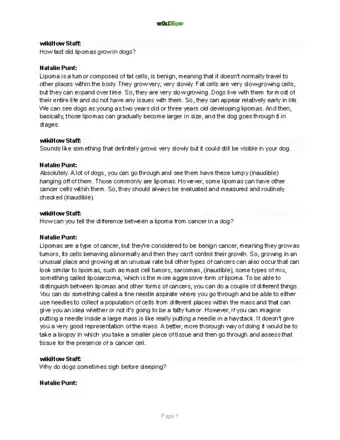
Thanks for reading our article! If you'd like to learn more about taking care of a dog, check out our in-depth interview with Natalie Punt, DVM.
References
- ↑ http://www.merckvetmanual.com/mvm/urinary_system/noninfectious_diseases_of_the_urinary_system_in_small_animals/urolithiasis_in_small_animals.html
- ↑ http://pets.webmd.com/dogs/my-dog-always-thirsty
- ↑ http://www.whole-dog-journal.com/issues/13_4/features/Detecting-Urinary-Stones-Dogs_16215-1.html
- ↑ http://www.whole-dog-journal.com/issues/13_4/features/Detecting-Urinary-Stones-Dogs_16215-1.html
- ↑ http://www.whole-dog-journal.com/issues/15_7/features/Home-Prepared-Dog-Food-Nutritional-Information_20568-1.html
- ↑ http://www.petmd.com/blogs/nutritionnuggets/jcoates/2013/nov/how-cranberry-can-be-used-to-prevent-urinary-infections-dogs-31002
- ↑ Cote, E, (2010), Clinical Veterinary Advisor: Dogs and Cats, ISBN 978-0323068642
- ↑ http://www.petmd.com/dog/conditions/urinary/c_dg_nephrolithiasis
- ↑ http://www.petmd.com/dog/conditions/urinary/c_dg_nephrolithiasis
